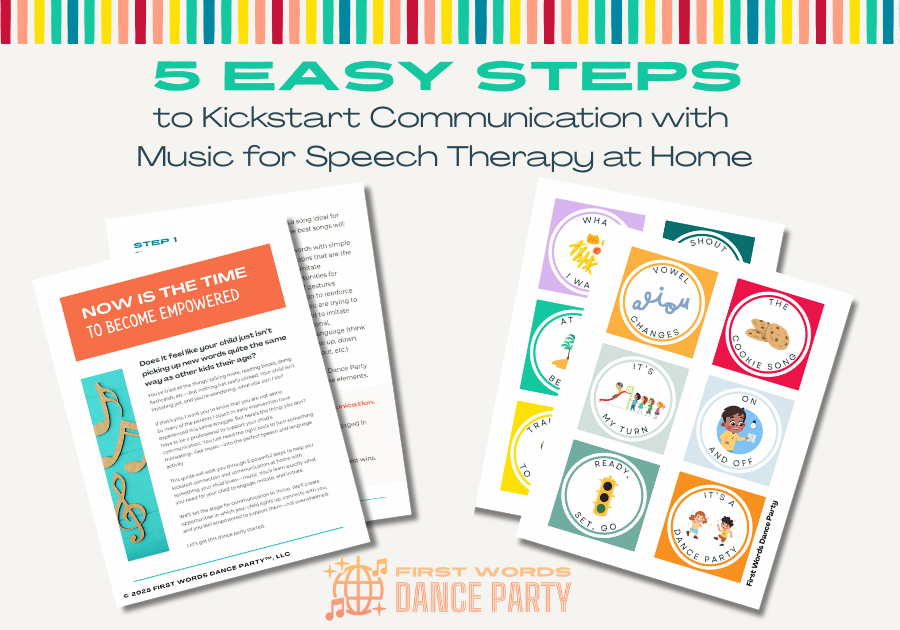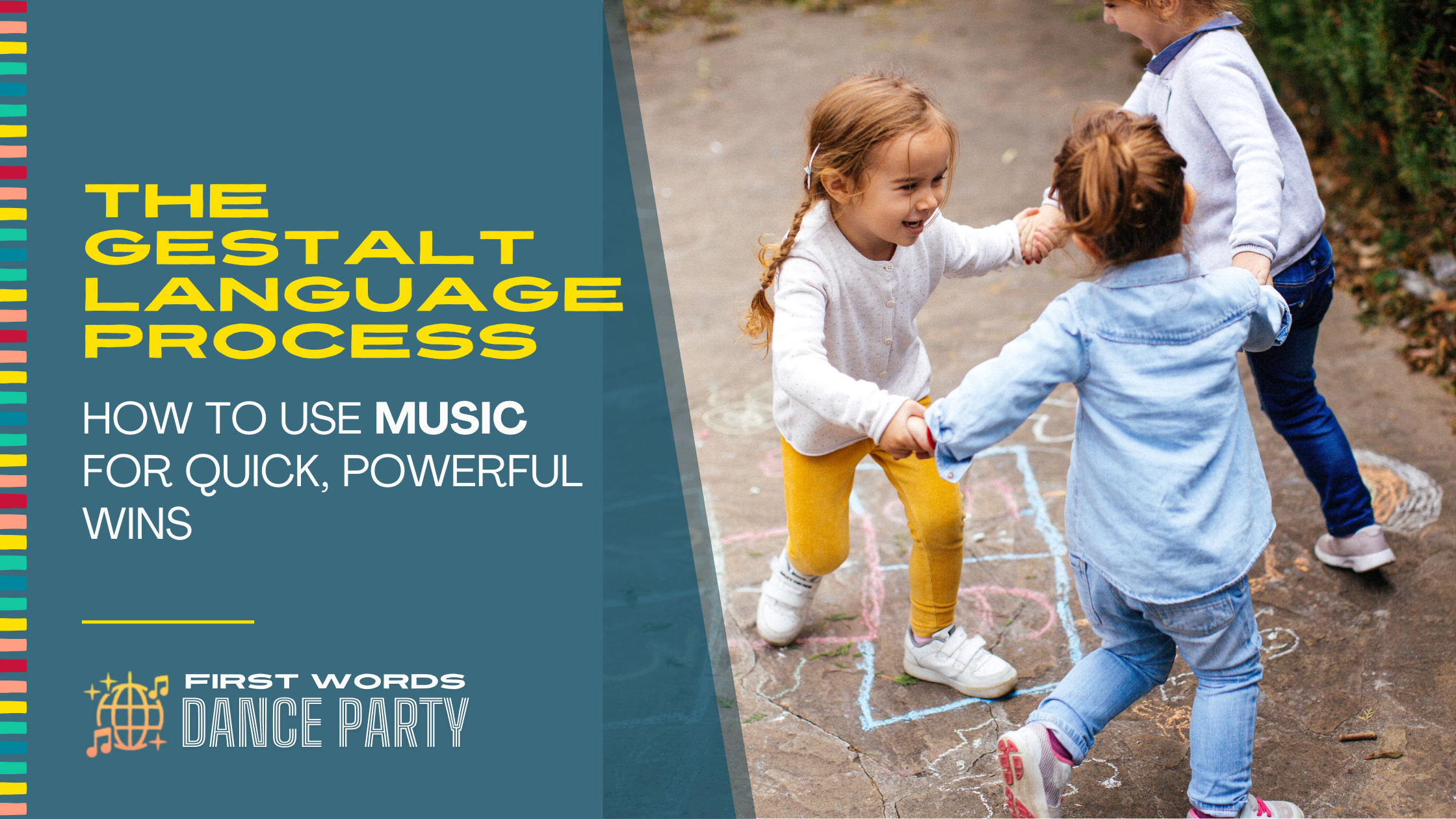Gestalt Language Processors Myths Debunked: 6 Untruths You'll Want to Nix
- 0 comments
In the speech and language world, there has been a lot of buzz lately about gestalt language processors.
It’s no surprise why- gestalt language processing is fascinating. But, as awareness grows and people wonder, “What is gestalt language processing?”, it’s easy to make assumptions that aren’t always true.
It doesn’t help that myths and outdated advice are everywhere, and many well-meaning tips miss the mark entirely for kids who don’t follow the typical analytic path to speech.
If you’re parenting a child who may be a gestalt language processor, you may be wondering what’s true and what isn’t. And if so, you’re not alone. This blog post is part 3 in a series all about understanding and supporting children who are gestalt language learners in simple, meaningful ways.
This post will tackle common myths about gestalt language processors and offer truths that are not only more accurate, but also more hopeful and affirming. If you’ve ever wondered whether scripting is “just echolalia,” whether prompting helps or hurts, or whether your child is progressing the right way, this one’s for you.
If your child isn’t using many words yet, you may be unsure of what to do and what not to do- and you’re not alone. Many parents I coach in early intervention feel stuck, frustrated, or overwhelmed when their child won’t imitate their words.
That’s why I started creating music for speech therapy that weaves in the strategies we use everyday in early intervention.
You can download a free guide to discover 5 easy, parent-friendly steps to use songs for speech therapy to spark connection and communication with your child. As a bonus, you’ll receive song boards with cards for every First Words Dance Party™ song, so your child can make choices and initiate.
Alright, let’s do some myth-busting.
Myth 1: “Gestalt language processors are just scripting without meaning.”
Truth: Echolalia is meaningful communication.
If your child repeats phrases from shows, songs, or routines, it’s not meaningless mimicry or stimming. These scripts are how they are processing and expressing themselves.
Gestalt language processors naturally learn language in chunks, often starting with scripts that carry emotional weight or are tied to familiar routines. Those phrases are intentional, even if they are repetitive or don’t sound like typical first words.
For example, a child who says “Let’s a-go!” (just like Mario) may be using it to show excitement, to signal that they want to play Mario, or to show that they want to go outside. It might not sound like a traditional request or comment, but it’s 100% meaningful.
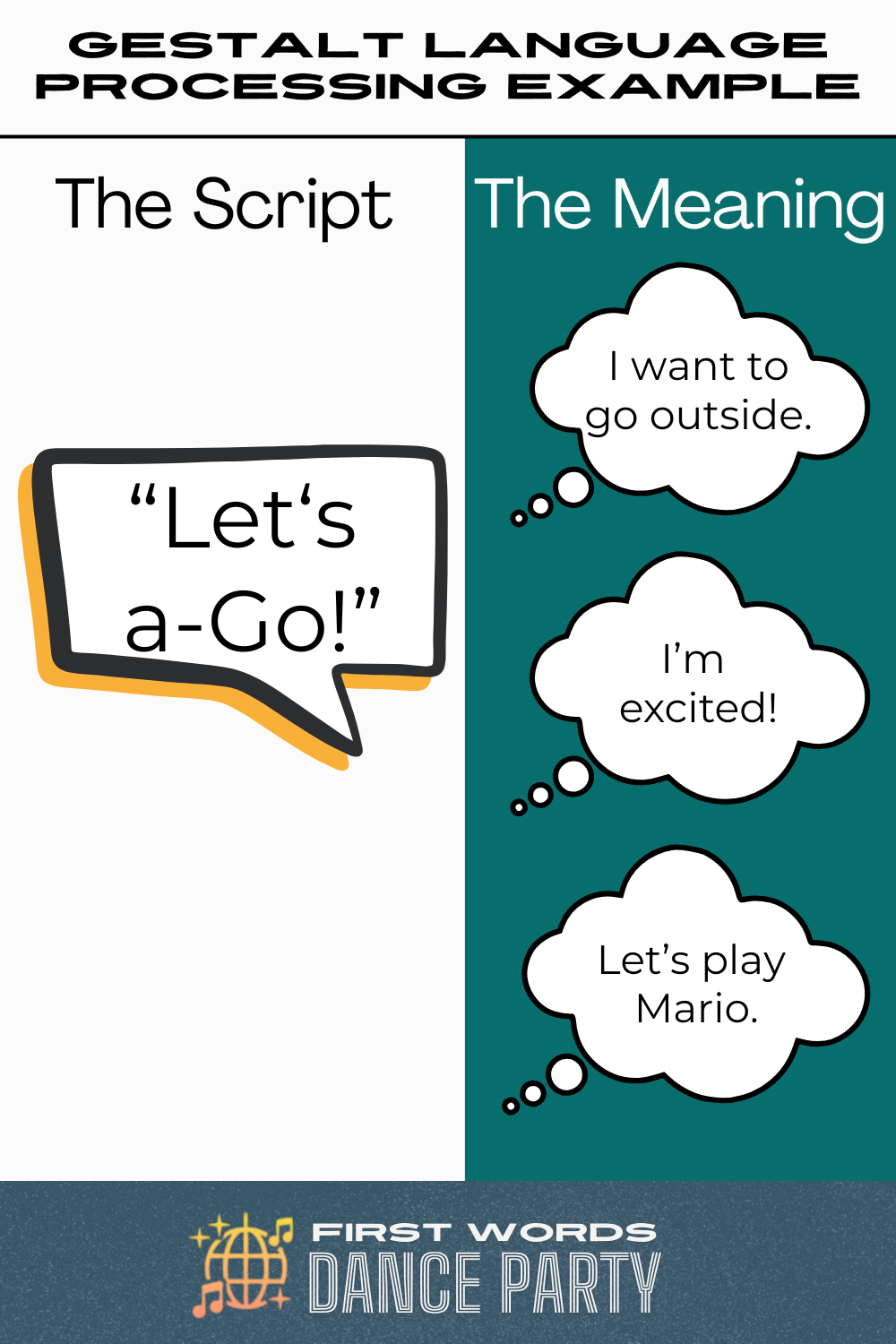
Dr. Barry Prizant, author of Uniquely Human, explains:
“What we call echolalia is not meaningless repetition, but a different—and very natural—form of language development.”
He also reminds us that these echoed scripts often carry deep emotional significance:
“Echolalia often reflects the emotional state of a person—when a phrase is repeated, it may be because that phrase is associated with a particular feeling, memory, or experience.”
Doing the detective work to understand your child
When we start thinking about a child’s scripts through the lens of “what is my child trying to tell me?”, we can start to see echolalia for what it truly is: a meaningful connection.
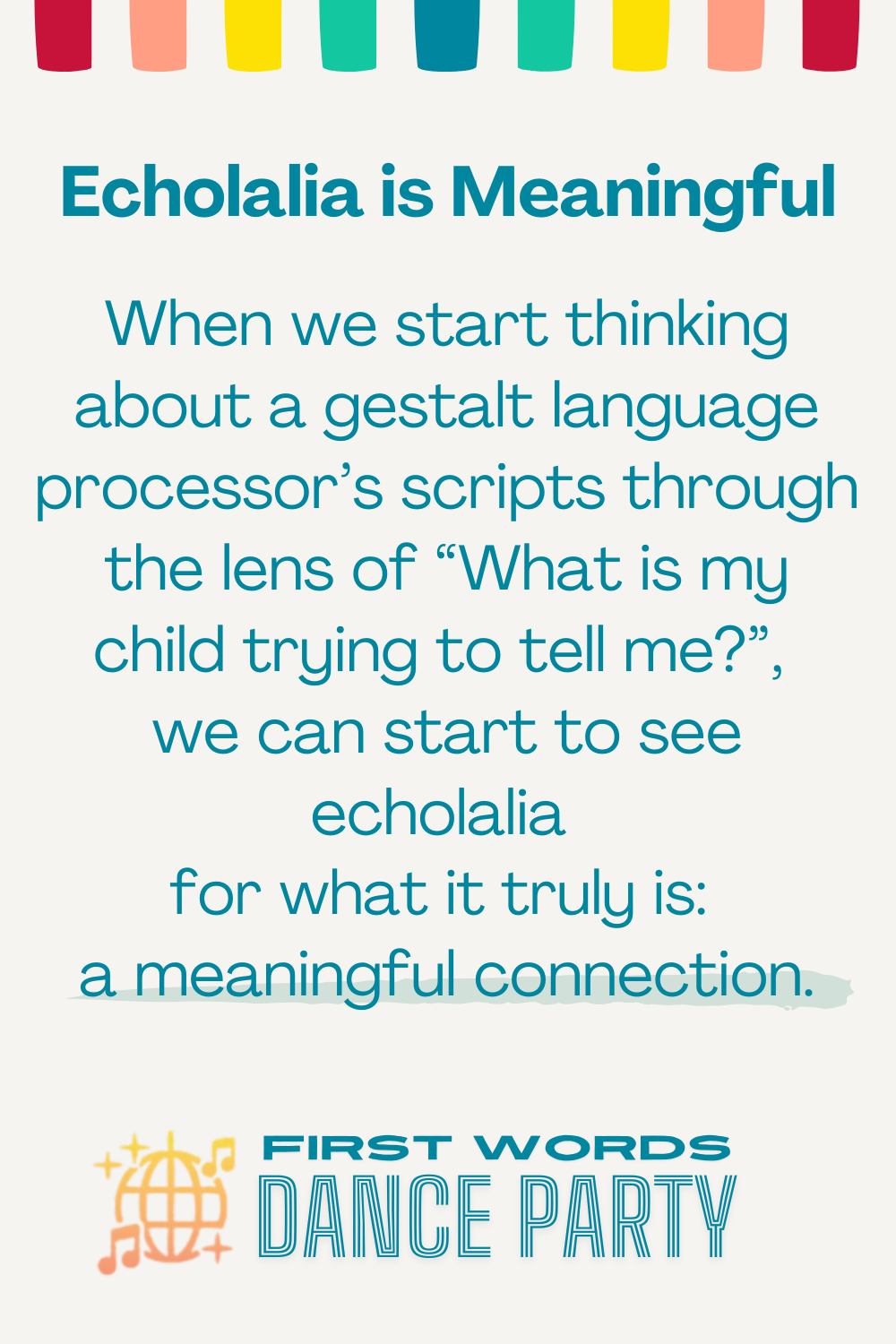
If you’re new to this topic, you can check out Part 1 of this series. This post answers the question, “What is a gestalt language processor?” by helping parents to recognize the early signs.
Many gestalt language examples are given to illustrate what a child may be trying to communicate with their scripts.
Myth 2: “Gestalt language learners need more prompting to help them succeed.”
Truth: More prompting doesn’t equal more progress—gestalt language processors often need less prompting and more space to process and respond.

It’s easy to fall into the habit of jumping in with questions, cues, or “Say ___” prompts, especially when you’re eager to help your child find their words. But too much prompting can interrupt the natural rhythm of communication for gestalt language learners.
It puts pressure on performance when what they really need is time, connection, and room to take the lead. Too much prompting can lead gestalt language learners to become reliant on others when our goal is for them to learn how to initiate.
What to do instead of prompting
One of the most powerful ways to support a gestalt language processor is by slowing things down. Doing this not only gives gestalt language learners more time to process, but it also helps to keep the interaction more natural.

Research in responsive interaction strategies supports this. Marge Blanc, Speech-Language Pathologist and author of Natural Language Acquisition on the Autism Spectrum, as well as speech-language pathologists at organizations like the Hanen Centre, emphasize the value of following a child’s lead. This means limiting adult turns to roughly 1 to 1.5 for every turn the child takes.
Think of it like a tennis game. After you take a turn, wait for your child to respond in some way (an action, a gesture, a sound, a word, or a script) before taking your next turn.
According to Blanc (2012), a more natural back-and-forth (versus high-pressure prompting) helps support the transition through the gestalt language processing stages.
So, instead of prompting your child with “Say ‘go!’” or “Can you say ‘go’?” during play, try modeling “Ready, set, go!” naturally in context. Then, pause and let your child take a turn in the interaction.
Myth 3: “There’s only one specific gestalt language processing treatment to help these kids to start talking.”
Truth: All learners are unique. The most important thing to remember for any gestalt language learner is to keep things natural.
Because this language path can feel unfamiliar, many parents worry they’re not responding the “right” way.
But here’s the truth: if you’re responding to your child naturally and with curiosity, you’re already doing so much right. You don’t have to get every word perfect.
What all gestalt language processors do need is support that feels natural and emotionally grounded. When you offer language models in meaningful moments, like during play, meals, and bathtime, you’re laying the foundation for growth.
Whether you’re using sign language, modeling language with AAC, or simply pausing and waiting in your interactions with your child to balance turns—you’re doing it right. The most important thing is to recognize whatever communicative turn your child takes (a gesture, an action, a script, etc.), to provide a model in response when you can, and to keep the interaction natural.
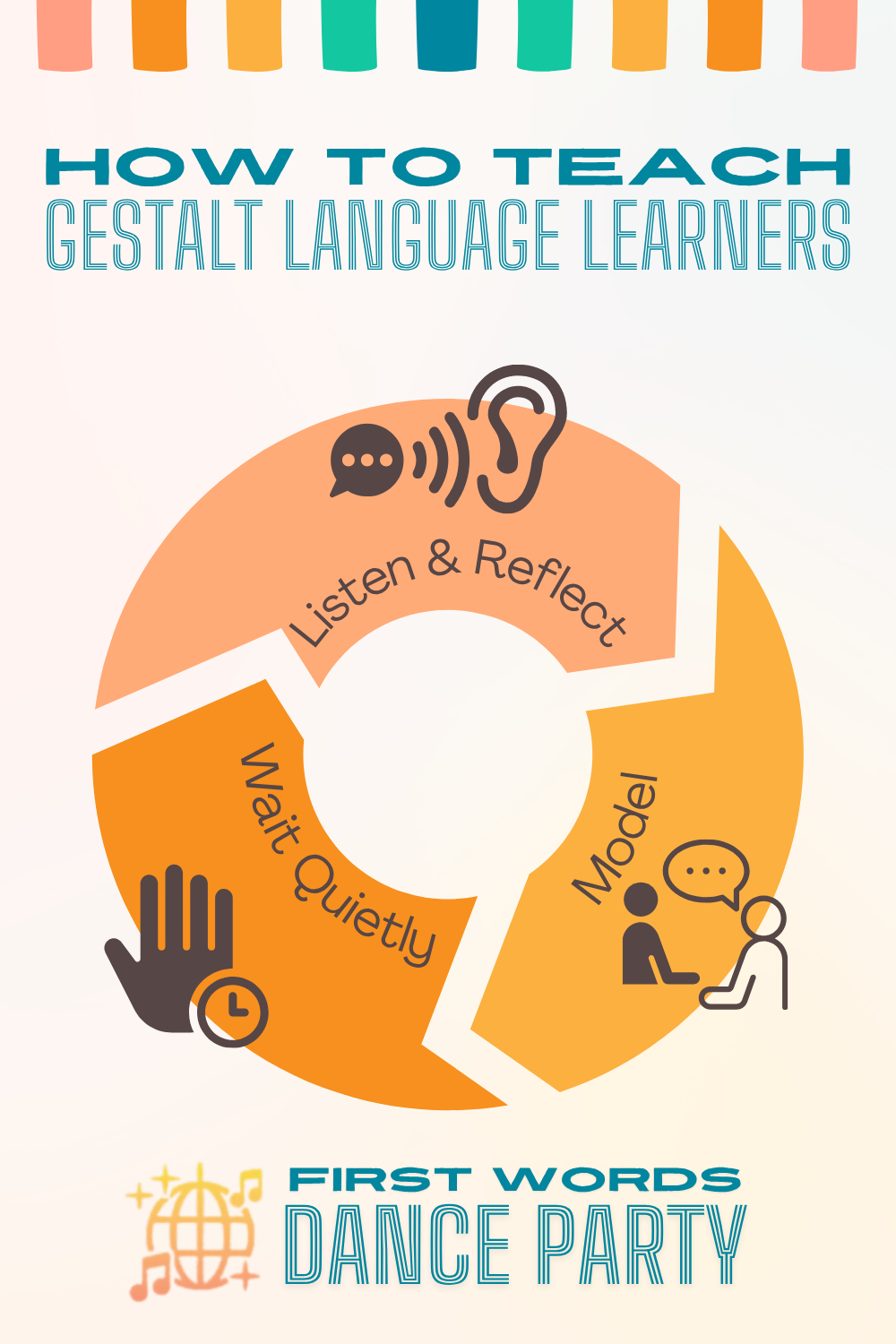
Using AAC for gestalt language learning
Curious how AAC fits into gestalt language development? This article from Meaningful Speech breaks down how to support gestalt language processors using AAC in a responsive, affirming way.
Myth 4: “Gestalt language processing only happens in autism.”
Truth: While many autistic children are gestalt language processors, not all gestalt language processors are autistic.
Because scripting and echolalia are often discussed within the context of autism, it’s easy to assume the two always go hand in hand. And yes, research does show that gestalt language processing is common in autistic children (Prizant & Duchan, 1981; Marge Blanc, 2012).
But- gestalt language processing and autism are not mutually exclusive.

Gestalt language processing and learning differences
Children with a variety of developmental profiles, including ADHD, sensory processing differences, apraxia of speech, and even some neurotypical children, can also be gestalt language learners.
The defining factor isn’t a diagnosis—it’s how they intrinsically process and produce language.
If your child speaks in scripts or sings full lines from songs, but they don’t use a wide variety single words in their interactions with others, they may be a gestalt language processor—regardless of diagnosis.
You don’t need a diagnosis to start supporting your child’s language development. You just need the right lens and the right tools.
Myth 5: “If they’re scripting or repeating phrases, they’re stuck.”
Truth: Scripting and repetition are how gestalt language processors learn, not a sign that they are stuck.
It can feel a bit weird to hear your child repeat the same phrases over and over again. Maybe it’s a line from a song or something from a cartoon that your kiddo seems to say completely out of context that makes you turn your head.
But for gestalt language processors, that scripting isn’t just noise. It’s how they process and internalize language.
Repetition is often a sign that a child is stabilizing a gestalt—a step that must come before they can naturally break it down and move toward self-generated language. It might look like they’re “stuck,” but repeated scripting can be a sign that your child is simply progressing through the gestalt language processing stages.
This is especially true if the phrases your child uses are consistent and tied to a specific routine or emotional moment.
What to do when your child is scripting
Try this: As you notice your child using a script, join them. Repeat the phrase back with the same intonation. You’ll be making a meaningful connection with your kiddo that shows you value their learning style.
Recognizing your child’s script is an important step of the gestalt language process.
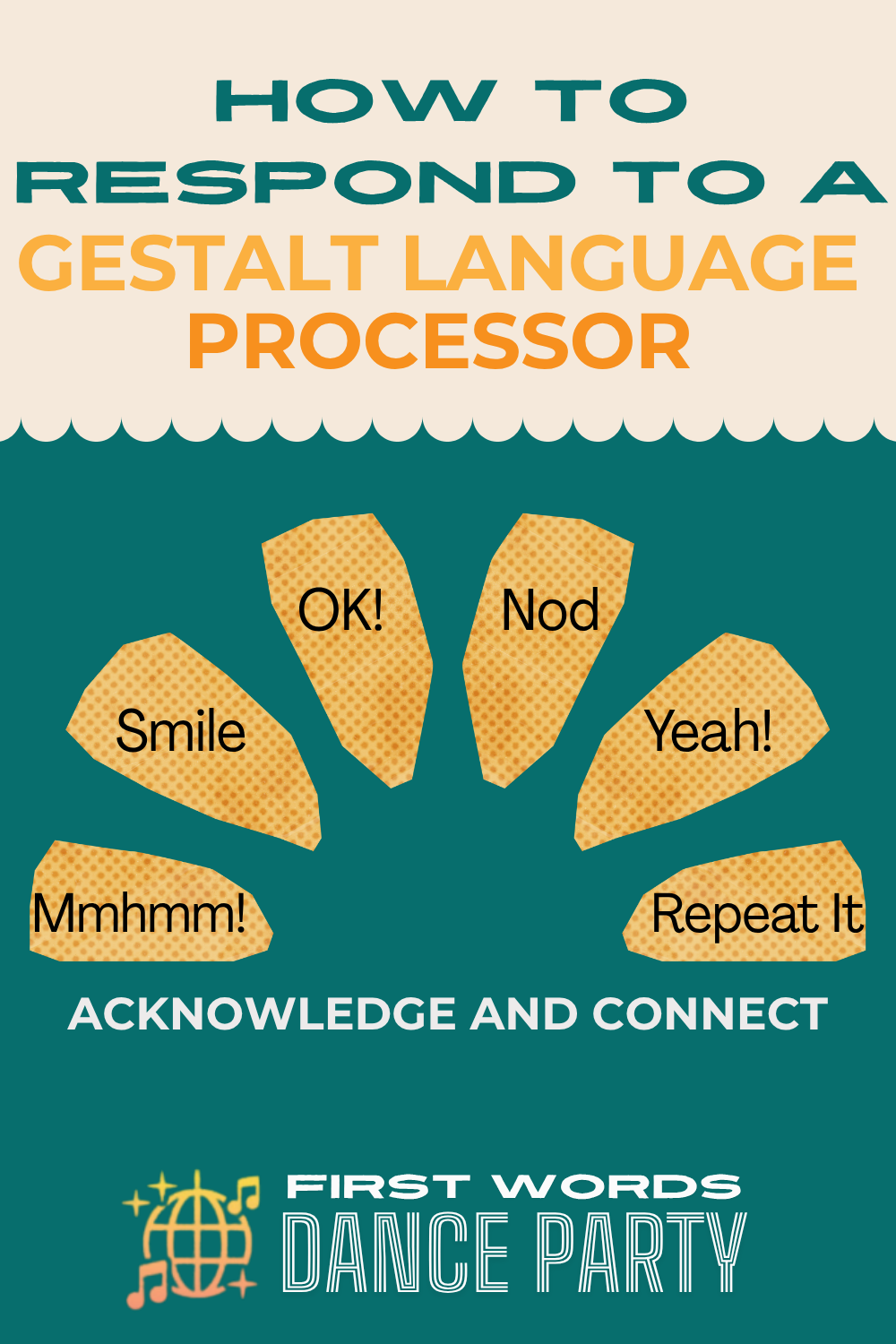
Myth 6: “A gestalt language learner will never use flexible, generative language.”
Truth: For a gestalt language learner, scripting is just the beginning—not the end.
Natural language acquisition unfolds gradually over time, and scripting is part of Stage 1 in the gestalt language processing stages. With support, children move from full scripts to partial gestalts, then to mix-and-match phrases, and eventually to truly flexible, generative language.
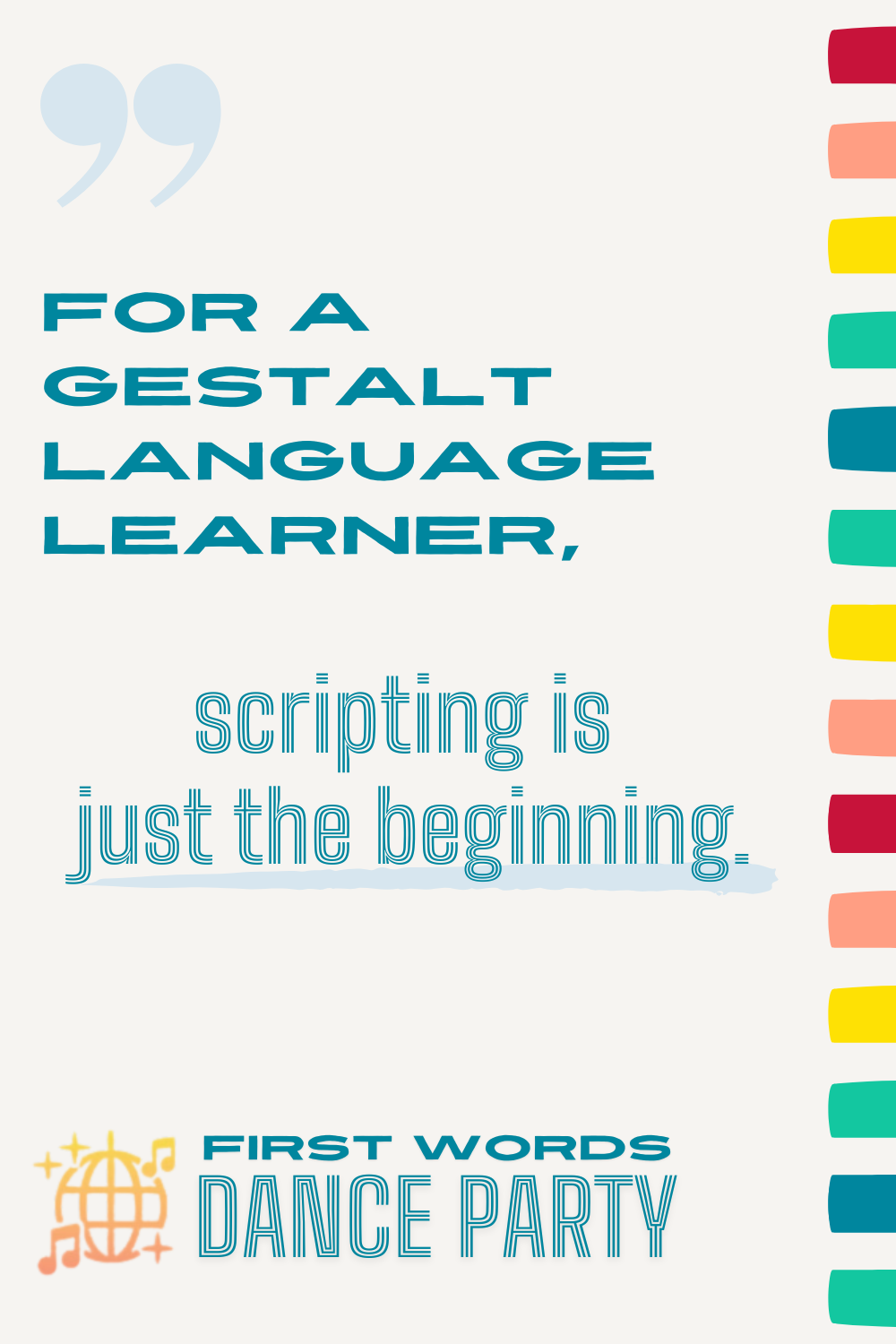
Gestalt language processing: 4 stages
Gestalt language processing stages typically unfold like this:
Stage 1: Complete gestalts (e.g., “Let’s go!” or “The wheels on the bus go round and round”)
Stage 2: Mitigated gestalts—shortened or combined scripts (e.g., “Let’s go round and round!”)
Stage 3: Single words used independently and intentionally and combined into two-word combinations (e.g., “Go up”, “Big bus”)
Stage 4: Flexible, self-generated phrases based on meaningful models

Moving from scripts to flexible language
A child who echoes, “Do you like broccoli?” (from a video of a favorite song) as a means to ask to watch TV may very well one day grow to say, “Let’s watch a show!”. When that happens, it will be because they’ve internalized the rhythm, emotional tone, and structure of language through those early scripts.
Progress for gestalt language learners looks very different than it does for analytic language learners, but that doesn’t mean it isn’t happening. With responsive communication partners, natural models, and time to process, gestalt language learners can absolutely develop original, self-generated language.
How to teach gestalt language learners
Keep modeling short, meaningful phrases that match the moment. That’s how your child gathers the building blocks they’ll use in later stages of gestalt language processing.

Does your kiddo love music? Gestalt language processors are referred to as intonation babies because of how in tune they are with the melody and prosody of language (no pun intended there- I swear that it really and truly just happened).
Music can be a very powerful tool to use with gestalt language learners. Curious how music can help your child progress? Check out Part 2 of this blog series for real-life gestalt language processing examples and strategies from common nursery rhymes.
First Words Dance Party: Catchy Songs and Music Videos for Gestalt Language Processors
Looking for a fun, low-pressure way to model rich scripts? First Words Dance Party is a collection of fun, original songs rich with natural, meaningful scripts.
For children who learn language in chunks, not just words, these original songs provide ready-made, functional phrases that can be repeated, generalized, and eventually transformed into more flexible speech.
Here are a few examples:
“The Cookie Song”: A kid favorite that models the words yes and no with lots of repetition and rhythm, along with the phrases "I wanna eat", "I'm hungry", "Let's eat, please"
"It's My Turn": An irresistibly fun and functional song for gestalt language processors. This song about sharing helps toddlers and children with speech delays learn the words necessary to ask others for a turn.
“Ready, Set, Go”: A super fun little number that models phrases like "I want more", "More bubbles", "Where'd it go?", and of course, "Ready, Set, Go!"
And “What I Want”: This one targets phrases to self-advocate, like "I want to go outside", "open the door", "I want to eat chicken nuggets", and "I want water, please". Check out the core word video below to see how you can model AAC along with the songs. (Note that this core video YouTube series does highlight core words at the individual word level, versus using one symbol to represent an entire phrase)
You can stream First Words Dance Party on Spotify, YouTube Music, Apple Music, and anywhere else you get your music.
Exclusive Upcoming Video Series
Ever feel like your child imitates things they see in videos, but it's almost impossible to get them to imitate you?
You're not alone. I can't tell you how many kiddos I've worked with who struggle to imitate, but there's something about watching a video that works some sort of magic.
It's what inspired me to create a brand new series of music videos that incorporate video modeling, AAC (Augmentative and Alternative Communication), and so much more.
Now, your child can experience the rhythmic, melodic gestalts in the songs as those scripts come alive with video modeling of real children engaging in real, daily routines.
This exclusive 10-video series brings each First Words Dance Party song to life with:
✅ Real children modeling language through daily routines like meals, playing with toys, and going to the playground
✅ Functional core words expressed through AAC, gestures, and sign language
✅ Aided language stimulation timed perfectly with the music
✅ Videos created specifically for gestalt language processors and children with speech delays
Unlike our free YouTube videos, these go far beyond lyrics. They show the "how"—how to use music to support expressive language, how to carry core words into real life, and how to use AAC to make language visible and accessible.
All in time with the lyrics of each song.
So you can experience the joy that comes with hearing your child say "up" and "help" for the first time. So your child can discover the power of their actions and their voice when you ask if they're hungry and they nod their head "yes".
Be the very first to know when the doors are opening by joining the waitlist.
Final Thoughts
Gestalt language processors are finally getting the attention they deserve—and that’s a good thing. But with all the buzz, it’s easy to get swept up in myths that leave you questioning whether you’re doing enough, doing it right, or doing it at all.
Here’s what matters most: your child’s scripts do have meaning. There is a path forward. And if you’re showing up with connection and curiosity, you’re already helping your child grow in ways that matter most.
Don’t forget to download your free 5 Easy Steps to Kickstart Communication with Music for Speech Therapy at Home and take the first step toward connection and communication with your little one.
There’s no single “right” way to support gestalt language processors—but there are strategies that affirm who they are and how they learn.
References
Blanc, M. (2012). Natural Language Acquisition on the Autism Spectrum: The Journey from Echolalia to Self-Generated Language. Whole Child Consulting.
Prizant, B. M., & Duchan, J. F. (1981). The functions of immediate echolalia in autistic children. Journal of Speech and Hearing Research, 24(2), 163–173.
Prizant, B. M. (2015). Uniquely Human: A Different Way of Seeing Autism. Simon & Schuster.
